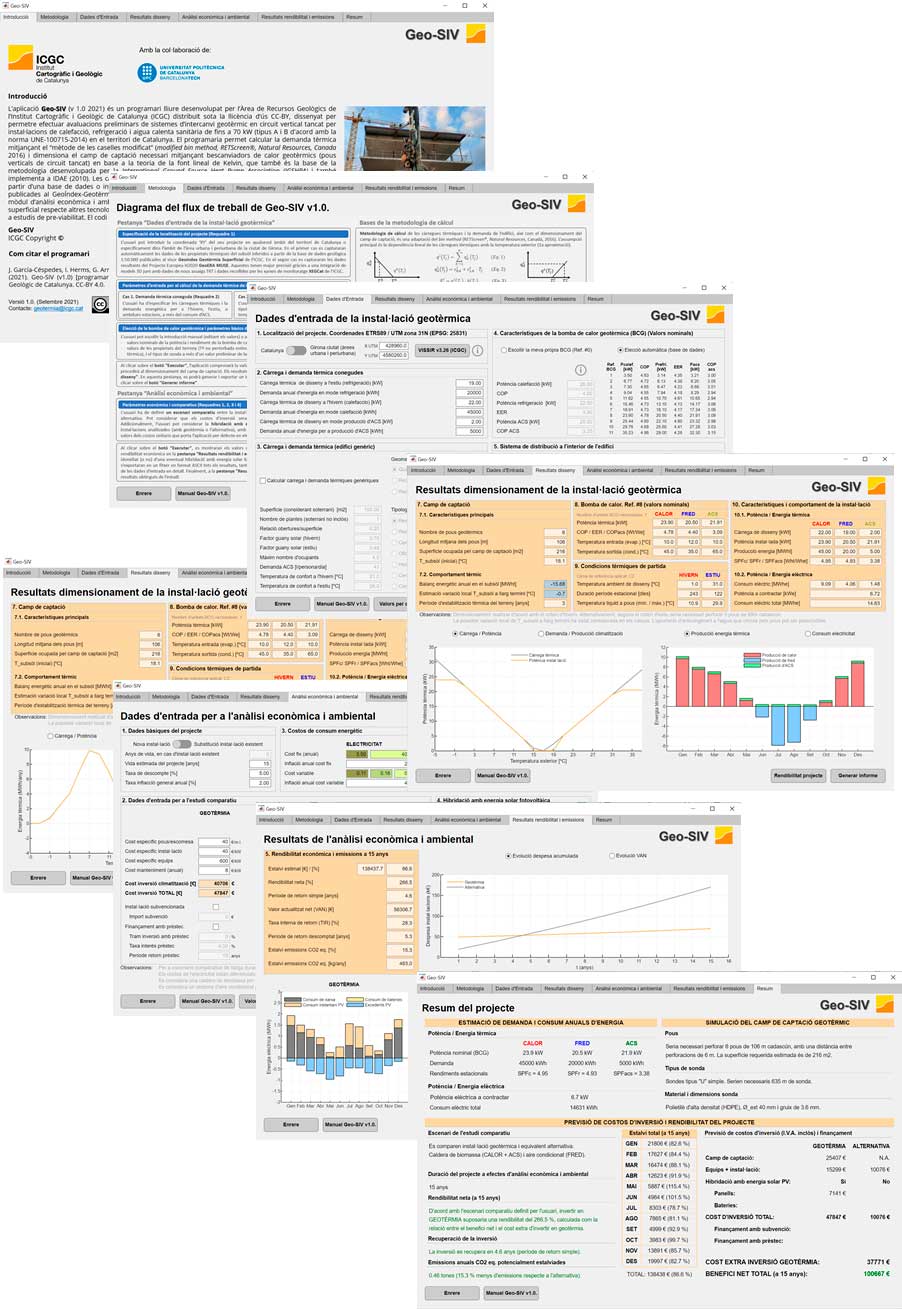Functionalities of Geo-SIV
The new software allows introducing the thermal loads and the demand for cold, heat and DHW or calculate it (for simplified cases) by realizing an adaptation of the bin method (RETScreen ®, Natural Resources Canada 2016).
Geo-SIV calculates the necessary number of heat exchangers (closed loop vertical wells) based on the Kelvin linear source theory. This is also the basis of the methodology developed by the International Ground Source Heat Pump Association (IGSHPA) and by the Instituto para la Diversificación y el Ahorro Energético (IDAE, 2012).
For the design of the heat exchangers, Geo-SIV allows specifying between types of single or double probes, their parameters and the distance between them. The characteristics of the geothermal heat pumps are selected from an internal database or can be introduced by the user. The tool uses geological and climatological data published in the Geoíndex-Surface geothermal of Catalonia (ICGC, 2018). For the specific area of Girona, it incorporates geoinformation based on the results of the MUSE project (GeoERA H2020 Era-Net, 2018-2021).
Geo-SIV has an economic and environmental analysis module that allows comparing the projected solution based on shallow geothermal energy with respect to other renewable and non-renewable technologies and calculates the amortization period of the extra investment involved as well as emission savings. It also makes possible to contemplate the possibility of hybridizing the thermal energy production facility with photovoltaic energy and battery systems.
The output data can be used for pre-feasibility studies.
The code has been programmed using MATLAB software (created with version 2020a, adapted and successfully tested up to version 2022b).

Geo-SIV flow line and its intuitive graphical interface
Software distribution
Geo-SIV is distributed as a compiled executable Microsoft Windows™ software.
The current Geo-SIV v1.3 (November 2023) version can be downloaded in a compiled ZIP file (Geo-SIV_v1.3; 103 MB) that contains:
- The Geo-SIV application (EXE)
- A use guide v.1.3 (PDF)
(*) NOTE: Geo-SIV takes into account the different parameters that can be used by the user. The precision of the base information used to establish the default values can be highly variable depending on the source of the information. It is recommended that the user always check the values that the program proposes by default and perform various simulations considering their variability.
Programme reference
J. García-Céspedes, I.Herms, G.Arnó, J.Ariza, J.J.De Felipe (2023). Geo-SIV (v1.3) [app]. Institut Cartogràfic i Geològic de Catalunya. CC-BY 4.0.
References
AENOR UNE-100715:2014 (2014): “Diseño, ejecución y seguimiento de una instalación geotérmica somera. Parte 1: Sistemas de circuito cerrado vertical”. Disponible a través del siguiente enlace: https://www.une.org/encuentra-tu-norma/busca-tu-norma/norma?c=N0052899
AENOR UNE-EN 14511-1:2019 (2019): “Acondicionadores de aire, enfriadoras de líquido y bombas de calor para la calefacción y la refrigeración de locales y enfriadoras de proceso con compresores accionados eléctricamente. Parte 1: Términos y definiciones”.
Ariza, J. (2020). “Implementation of methodologies for calculating vertical Borehole Heat Exchangers (BHE) lengths for Ground source heat pumps (GSHP) systems in MATLAB: Design of an App”. Thesis of the Master’s degree on Energy Engineering. School of Industrial Engineering of Barcelona. Tutors / directors: De Felipe, J,; Herms I. https://upcommons.upc.edu/bitstream/handle/2117/333862/tfm-javier-ariza-vdef.pdf?sequence=1&isAllowed=y.
ASHRAE (American Society of Heating, Refrigerating, and Air Conditioning Engineers) (1985): “ASHRAE Handbook of Fundamentals Volume”.
ICGC (2018): “Geoíndex. Geotèrmia superficial”. Disponible a través del siguiente enlace: www.icgc.cat/ca/Administracio-i-empresa/Eines/Visualitzadors-Geoindex/Geoindex-Geotermia-superficial.
IDAE (Instituto para la Diversificación y el Ahorro Energético) (2012): “Guía técnica de diseño de sistemas de intercambio geotérmico de circuito cerrado”. Disponible a través del siguiente enlace: https://www.idae.es/publicaciones/guia-tecnica-diseno-de-sistemas-de-intercambio-geotermico-de-circuito-cerrado
Ingersoll, L.R.; Plass, H.J. (1948): “Theory of the ground pipe heat source for the heat pump”. ASHVE Trans., 47: 339-348.
IGSHPA (International Ground Source Heat Pump Association) (2009): “Ground source heat pump residential and light commercial: design and installation guide”.
García-Céspedes, J.; Herms, I.; Arnó, G.; Ariza, J.; De Felipe, J. J. (2022): Geo-SIV (v1.1) [programari]. Institut Cartogràfic i Geològic de Catalunya i Universitat Politècnica de Catalunya. CC-BY 4.0.
MITMA (Ministerio de Transportes, Movilidad y Agencia Urbana) (2019): “Código Técnico de la Edificación (CTE). Documento Básico HE Ahorro de energía (HE)”.
NRCAN (Ministry of Natural Resources, Canada) (2005): “RETScreen® International: Clean Energy Decision Support Centre. Ground-Source Heat Pump Project Analysis”. Disponible a través del siguiente enlace: https://publications.gc.ca/collections/Collection/M39-111-2005E.pdf.
NRCAN (Ministry of Natural Resources, Canada) (2016): “RETScreen® International: “RETScreen Clean Energy Management Software”. Disponible a través del següent enllaç: www.nrcan.gc.ca/maps-tools-and-publications/tools/modelling-tools/retscreen/7465.
Yang, H.; Cui, P.; Fang, Z. (2019): “Vertical-borehole ground-coupled heat pumps: A review of models and Systems”, Applied Energy, 87: 16-27.

 Contact
Contact










